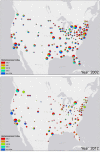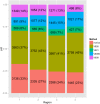Identifying Homelessness among Veterans Using VA Administrative Data: Opportunities to Expand Detection Criteria
- PMID: 26172386
- PMCID: PMC4501742
- DOI: 10.1371/journal.pone.0132664
Identifying Homelessness among Veterans Using VA Administrative Data: Opportunities to Expand Detection Criteria
Abstract
Researchers at the U.S. Department of Veterans Affairs (VA) have used administrative criteria to identify homelessness among U.S. Veterans. Our objective was to explore the use of these codes in VA health care facilities. We examined VA health records (2002-2012) of Veterans recently separated from the military and identified as homeless using VA conventional identification criteria (ICD-9-CM code V60.0, VA specific codes for homeless services), plus closely allied V60 codes indicating housing instability. Logistic regression analyses examined differences between Veterans who received these codes. Health care services and co-morbidities were analyzed in the 90 days post-identification of homelessness. VA conventional criteria identified 21,021 homeless Veterans from Operations Enduring Freedom, Iraqi Freedom, and New Dawn (rate 2.5%). Adding allied V60 codes increased that to 31,260 (rate 3.3%). While certain demographic differences were noted, Veterans identified as homeless using conventional or allied codes were similar with regards to utilization of homeless, mental health, and substance abuse services, as well as co-morbidities. Differences were noted in the pattern of usage of homelessness-related diagnostic codes in VA facilities nation-wide. Creating an official VA case definition for homelessness, which would include additional ICD-9-CM and other administrative codes for VA homeless services, would likely allow improved identification of homeless and at-risk Veterans. This also presents an opportunity for encouraging uniformity in applying these codes in VA facilities nationwide as well as in other large health care organizations.
Conflict of interest statement
Figures


Similar articles
-
One-year incidence and predictors of homelessness among 300,000 U.S. Veterans seen in specialty mental health care.Psychol Serv. 2017 May;14(2):203-207. doi: 10.1037/ser0000083. Psychol Serv. 2017. PMID: 28481605
-
Association of substance use and VA service-connected disability benefits with risk of homelessness among veterans.Am J Addict. 2011 Sep-Oct;20(5):412-9. doi: 10.1111/j.1521-0391.2011.00166.x. Epub 2011 Aug 11. Am J Addict. 2011. PMID: 21838839
-
VA health service utilization for homeless and low-income Veterans: a spotlight on the VA Supportive Housing (VASH) program in greater Los Angeles.Med Care. 2014 May;52(5):454-61. doi: 10.1097/MLR.0000000000000112. Med Care. 2014. PMID: 24714583 Free PMC article.
-
Understanding the health of veterans who are homeless: A review of the literature.Public Health Nurs. 2017 Sep;34(5):505-511. doi: 10.1111/phn.12338. Epub 2017 Jul 4. Public Health Nurs. 2017. PMID: 28675540 Review.
-
Primary Care for Veterans Experiencing Homelessness: a Narrative Review of the Homeless Patient Aligned Care Team (HPACT) Model.J Gen Intern Med. 2023 Feb;38(3):765-783. doi: 10.1007/s11606-022-07970-y. Epub 2022 Nov 28. J Gen Intern Med. 2023. PMID: 36443628 Free PMC article. Review.
Cited by
-
Risk factors for Veteran food insecurity: findings from a National US Department of Veterans Affairs Food Insecurity Screener.Public Health Nutr. 2022 Apr;25(4):819-828. doi: 10.1017/S1368980021004584. Epub 2021 Nov 8. Public Health Nutr. 2022. PMID: 34743780 Free PMC article.
-
Opioid agonist treatment uptake within provincial correctional facilities in British Columbia, Canada.Addiction. 2022 May;117(5):1353-1362. doi: 10.1111/add.15737. Epub 2021 Nov 19. Addiction. 2022. PMID: 34729848 Free PMC article.
-
Association of Homelessness and Unstable Housing With Cardiovascular Care Utilization Among Veterans.Circ Cardiovasc Qual Outcomes. 2024 Nov;17(11):e010993. doi: 10.1161/CIRCOUTCOMES.124.010993. Epub 2024 Nov 4. Circ Cardiovasc Qual Outcomes. 2024. PMID: 39492715
-
Utilization of Electroconvulsive Therapy for Older Homeless Adults Covered by Medicare.Psychiatr Q. 2021 Dec;92(4):1825-1837. doi: 10.1007/s11126-021-09946-3. Epub 2021 Sep 1. Psychiatr Q. 2021. PMID: 34468909
-
Homeless Veterans in Nursing Homes: Care for Complex Medical, Substance Use, and Social Needs.J Am Geriatr Soc. 2019 Aug;67(8):1707-1712. doi: 10.1111/jgs.15993. Epub 2019 Jun 17. J Am Geriatr Soc. 2019. PMID: 31206592 Free PMC article.
References
-
- Balshem H, Christensen V, Tuepker A, Kansagara D (2011) A Critical Review of the Literature Regarding Homelessness Among Veterans In: US Department of Veterans Affairs, editor. A Critical Review of the Literature Regarding Homelessness Among Veterans. Washington (DC). - PubMed
-
- The U.S. Department of Housing and Urban Development (2013) The 2013 Annual Homeless Assessment Report (AHAR) to Congress: Part 1 Point-in-Time Estimates of Homelessness. In: Development TUSDoHaU, editor. Washington DC: The U.S. Department ofHousing and Urban Development.
-
- U.S. Department of Veterans Affairs (2008) STATEMENT OF PETER H. DOUGHERTY, DIRECTOR, HOMELESS VETERANS PROGRAMS, DEPARTMENT OF VETERANS AFFAIRS In: US Department of Veterans Affairs, editor. Washington DC.
-
- Himelhoch S, McCarthy JF, Ganoczy D, Medoff D, Dixon LB, Blow FC (2007) Understanding associations between serious mental illness and HIV among patients in the VA Health System. Psychiatr Serv 58: 1165–1172. - PubMed
-
- Blow F, McCarthy J (2010) Care for Veterans with Psychosis in the Veterans Health Administration, FY10, 12th Annual National Psychosis Registry Report. In: US Department of Veterans Affairs, editor.
Publication types
MeSH terms
LinkOut - more resources
Full Text Sources
Other Literature Sources
Medical

